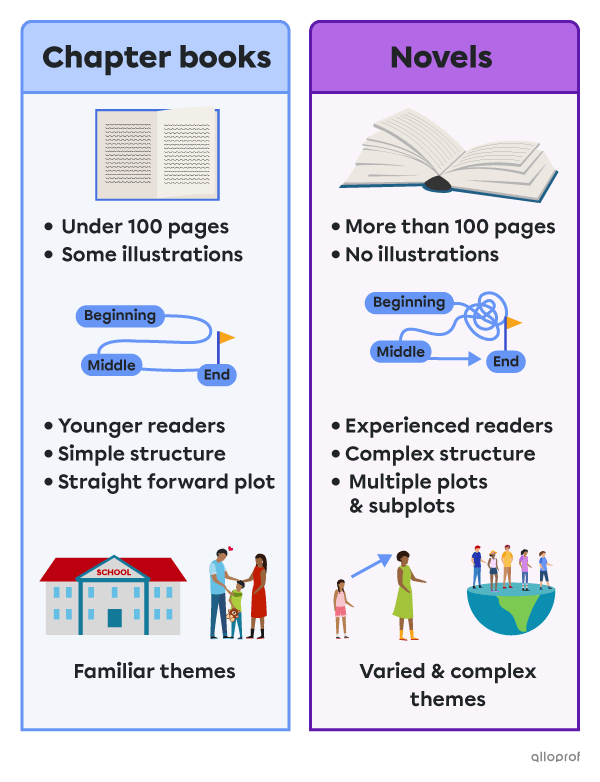Code de contenu
e1241
Slug (identifiant)
chapter-books-novels-text-types-elementary
Contenu parent
Niveaux
Grade 3
Grade 4
Grade 5
Grade 6
Matière
English Language Arts
Contenu
Titre (niveau 2)
What Are Chapter Books & Novels?
Slug (identifiant) du title
what-are-chapter-books-novels
Contenu
Corps
Chapter Books and novels are books that tell stories divided into parts called chapters.
Chapter books are shorter and tell simpler stories than novels.
Titre (niveau 2)
How Are Chapter Books & Novels Different?
Slug (identifiant) du title
how-are-chapter-books-novels-different
Contenu
Corps
Here are the key differences between chapter books and novels.
| Chapter Books | Novels | |
| Length | short | longer |
| under 100 pages | over 100 pages | |
| Illustrations | contain illustrations to support the text | rarely contain illustrations |
| Reading level | suitable for younger readers | for more experienced readers |
| (6-10 years old) | (10 years old and up) | |
| Structure | simple stories | more complex stories |
| with a clear beginning, middle and end | using varied literary devices | |
| Plot | generally one main plotline | possibly multiple plots |
| straightforward and linear | possibly connected subplots | |
| Themes | relatable and familiar | wider range and more complex themes |
| ex: family, friendship or school | ex: coming of age and broader social issues |
Image

Titre (niveau 2)
What Can We Expect to Find in Chapter Books & Novels?
Slug (identifiant) du title
what-can-we-expect-to-find-in-chapter-books-novels
Contenu
Corps
Here are some common elements in chapter books and novels.
| Chapter books | Novels | |
| Chapters | short chapters | longer chapters |
| focusing on 1 story element | with multiple story elements | |
| Vocabulary | simple vocabulary | advanced vocabulary |
| to help with the fluency of reading | use of figurative language | |
| Dialogue | dialogue-driven stories | balance of dialogue and narration |
| with some narration | ||
| ex: descriptions, exposition… | ||
| Characters & setting | relatable | more varied |
| familiar to the reader | detailed & developed | |
| Series | often serialized stories | may be serialized |
| may be standalone stories |
Image

Titre (niveau 2)
Chapter Books & Novels at a Glance
Slug (identifiant) du title
chapter-books-novels-at-a-glance
Contenu
Image

Texte bouton
Click to download.
Titre (niveau 2)
See Also
Slug (identifiant) du title
see-also
Contenu
Liens
Type
Interne
Titre
Biographies, Autobiographies & Memoirs – Types of Texts | Elementary
Lien interne
Retirer la lecture audio
Non
Outil imprimable
Off